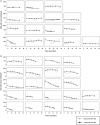Injecting drug use is associated with a more rapid CD4 cell decline among treatment naïve HIV-positive patients in Indonesia
- PMID: 24388495
- PMCID: PMC3880941
- DOI: 10.7448/IAS.17.1.18844
Injecting drug use is associated with a more rapid CD4 cell decline among treatment naïve HIV-positive patients in Indonesia
Abstract
Background: It remains unclear whether the natural course of human immunodeficiency virus (HIV) differs in subjects infected through injecting drug use (IDU) and no data have been published from low- or middle-income countries. We addressed this question in an urban cohort in Indonesia, which is experiencing a rapidly growing HIV epidemic strongly driven by IDU.
Methods: All antiretroviral treatment (ART) naïve HIV-positive patients who had at least two subsequent CD4 cell counts available before starting ART were included in this study. We examined the association between IDU and CD4 cell decline using a linear mixed model, with adjustment for possible confounders such as HIV viral load and hepatitis C antibodies.
Results: Among 284 HIV-positive ART naïve patients, the majority were male (56%) with a history of IDU (79% among men). People with a history of IDU had a statistically significant faster decline in CD4 cells (p<0.001). Based on our data, patients with a history of IDU would have an average 33% decline in CD4 cells after one year without ART, compared with a 22% decline among non-users. At two years, the decline would average 66 and 40%, respectively. No other factor was significantly associated with CD4 cell decline.
Conclusions: We show that a history of IDU is associated with a more rapid CD4 cell natural decline among HIV-positive individuals in Indonesia. These findings have implications for monitoring ART naïve patients with a history of IDU and for starting ART in this group.
Keywords: CD4-positive T-Lymphocytes; Indonesia; cohort studies; human immunodeficiency virus; injecting drug use (IDU).
Figures


Similar articles
-
Active and latent tuberculosis among HIV-positive injecting drug users in Indonesia.J Int AIDS Soc. 2015 Feb 16;18(1):19317. doi: 10.7448/IAS.18.1.19317. eCollection 2015. J Int AIDS Soc. 2015. PMID: 25690530 Free PMC article.
-
Association of alcohol abuse and injection drug use with immunologic and virologic responses to HAART in HIV-positive patients from urban community health clinics.J Community Health. 2008 Apr;33(2):69-77. doi: 10.1007/s10900-007-9069-1. J Community Health. 2008. PMID: 18046634
-
Lower prevalence and incidence of HIV-1 syncytium-inducing phenotype among injecting drug users compared with homosexual men.AIDS. 1995 Sep;9(9):1085-92. doi: 10.1097/00002030-199509000-00016. AIDS. 1995. PMID: 8527083
-
Risk of resistance to highly active antiretroviral therapy among HIV-positive injecting drug users: a meta-analysis.Lancet Infect Dis. 2010 Jul;10(7):464-9. doi: 10.1016/S1473-3099(10)70097-9. Lancet Infect Dis. 2010. PMID: 20610328 Review.
-
[Consensus document of Gesida and Spanish Secretariat for the National Plan on AIDS (SPNS) regarding combined antiretroviral treatment in adults infected by the human immunodeficiency virus (January 2012)].Enferm Infecc Microbiol Clin. 2012 Jun;30(6):e1-89. doi: 10.1016/j.eimc.2012.03.006. Epub 2012 May 23. Enferm Infecc Microbiol Clin. 2012. PMID: 22633764 Spanish.
Cited by
-
GSK3β-activation is a point of convergence for HIV-1 and opiate-mediated interactive neurotoxicity.Mol Cell Neurosci. 2015 Mar;65:11-20. doi: 10.1016/j.mcn.2015.01.001. Epub 2015 Jan 20. Mol Cell Neurosci. 2015. PMID: 25616162 Free PMC article.
-
Factors mediating and associated with immunological response in women living with HIV in Sweden: A nationwide register-based study.HIV Med. 2025 Jun 12;26(8):1311-6. doi: 10.1111/hiv.70059. Online ahead of print. HIV Med. 2025. PMID: 40501210 Free PMC article.
-
Active and latent tuberculosis among HIV-positive injecting drug users in Indonesia.J Int AIDS Soc. 2015 Feb 16;18(1):19317. doi: 10.7448/IAS.18.1.19317. eCollection 2015. J Int AIDS Soc. 2015. PMID: 25690530 Free PMC article.
-
Heroin use is associated with suppressed pro-inflammatory cytokine response after LPS exposure in HIV-infected individuals.PLoS One. 2015 Apr 1;10(4):e0122822. doi: 10.1371/journal.pone.0122822. eCollection 2015. PLoS One. 2015. PMID: 25830312 Free PMC article.
-
HIV treatment outcomes among people who acquired HIV via injecting drug use in the Asia-Pacific region: a longitudinal cohort study.J Int AIDS Soc. 2021 May;24(5):e25736. doi: 10.1002/jia2.25736. J Int AIDS Soc. 2021. PMID: 34021711 Free PMC article.
References
-
- UNAIDS. Injecting drug use: focussed HIV prevention works. 2007. [cited 2013 1 July 2013]; Available from: http://www.unaids.org/en/Resources/PressCentre/Featurestories/2007/May/2....
-
- Kapadia F, Vlahov D, Donahoe RM, Friedland G. The role of substance abuse in HIV disease progression: reconciling differences from laboratory and epidemiologic investigations. Clin Infect Dis. 2005;41(7):1027–34. - PubMed
-
- Wang J, Barke RA, Ma J, Charboneau R, Roy S. Opiate abuse, innate immunity, and bacterial infectious diseases. Arch Immunol Ther Exp. 2008;56(5):299–309. - PubMed
-
- Donahoe RM, Vlahov D. Opiates as potential cofactors in progression of HIV-1 infections to AIDS. J Neuroimmunol. 1998;83(1–2):77–87. - PubMed
Publication types
MeSH terms
LinkOut - more resources
Full Text Sources
Other Literature Sources
Research Materials

